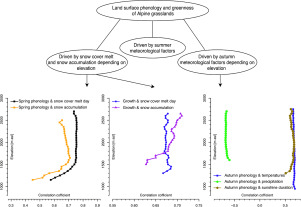当前位置:
X-MOL 学术
›
Sci. Total Environ.
›
论文详情
Our official English website, www.x-mol.net, welcomes your
feedback! (Note: you will need to create a separate account there.)
Land surface phenology and greenness in Alpine grasslands driven by seasonal snow and meteorological factors.
Science of the Total Environment ( IF 8.2 ) Pub Date : 2020-04-04 , DOI: 10.1016/j.scitotenv.2020.138380 Jing Xie 1 , Tobias Jonas 2 , Christian Rixen 2 , Rogier de Jong 1 , Irene Garonna 1 , Claudia Notarnicola 3 , Sarah Asam 4 , Michael E Schaepman 1 , Mathias Kneubühler 1
Science of the Total Environment ( IF 8.2 ) Pub Date : 2020-04-04 , DOI: 10.1016/j.scitotenv.2020.138380 Jing Xie 1 , Tobias Jonas 2 , Christian Rixen 2 , Rogier de Jong 1 , Irene Garonna 1 , Claudia Notarnicola 3 , Sarah Asam 4 , Michael E Schaepman 1 , Mathias Kneubühler 1
Affiliation

|
Snow accumulation and melt have multiple impacts on Land Surface Phenology (LSP) and greenness in Alpine grasslands. Our understanding of these impacts and their interactions with meteorological factors are still limited. In this study, we investigate this topic by analyzing LSP dynamics together with potential drivers, using satellite imagery and other data sources. LSP (start and end of season) and greenness metrics were extracted from time series of vegetation and leaf area index. As explanatory variables we used snow accumulation, snow cover melt date and meteorological factors. We tested for inter-annual co-variation of LSP and greenness metrics with seasonal snow and meteorological metrics across elevations and for four sub-regions of natural grasslands in the Swiss Alps over the period 2003-2014. We found strong positive correlations of snow cover melt date and snow accumulation with the start of season, especially at higher elevation. Autumn temperature was found to be important at the end of season below 2000 m above sea level (m asl), while autumn precipitation was relevant above 2000 m asl, indicating climatic growth limiting factors to be elevation dependent. The effects of snow and meteorological factors on greenness revealed that this metric tends to be influenced by temperatures at high elevations, and by snow melt date at low elevations. Given the high sensitivity of alpine grassland ecosystems, these results suggest that alpine grasslands may be particularly affected by future changes in seasonal snow, to varying degree depending on elevation.
中文翻译:

受季节性降雪和气象因素驱动的高寒草原地表物候和绿色变化。
积雪和融雪对高山草原的地表物候(LSP)和绿色度有多种影响。我们对这些影响及其与气象因素的相互作用的理解仍然有限。在这项研究中,我们使用卫星图像和其他数据源,通过分析LSP动态以及潜在的驱动因素,来研究该主题。从植被和叶面积指数的时间序列中提取LSP(季节的开始和结束)和绿色度指标。作为解释变量,我们使用了积雪,积雪融化日期和气象因素。我们测试了2003-2014年间瑞士阿尔卑斯山高海拔地区和四个自然草地子区域的LSP和绿色度指标与季节降雪和气象指标的年际协变。我们发现,积雪融化日期和积雪与季节开始,尤其是在海拔较高时,具有很强的正相关关系。在海拔2000 m以下的秋季结束时,秋季温度被认为是重要的,而海拔2000 m以上的秋季降水是相关的,这表明气候增长限制因素与海拔高度有关。降雪和气象因素对绿色的影响表明,该度量标准倾向于受高海拔温度和低海拔雪融化日期的影响。鉴于高山草原生态系统的高度敏感性,这些结果表明,高山草原可能会受到未来季节性季节降雪的特别影响,具体取决于海拔高度。特别是在高海拔地区。在海拔2000 m以下的秋季结束时,秋季温度被认为是重要的,而海拔2000 m以上的秋季降水是相关的,这表明气候增长限制因素与海拔高度有关。降雪和气象因素对绿色的影响表明,该度量标准倾向于受高海拔温度和低海拔雪融化日期的影响。鉴于高寒草地生态系统的高度敏感性,这些结果表明,高寒草地可能会受到未来季节性季节降雪的特别影响,具体取决于海拔高度。特别是在高海拔地区。在海拔2000 m以下的秋季结束时,秋季温度被认为是重要的,而海拔2000 m以上的秋季降水是相关的,这表明气候增长限制因素与海拔高度有关。降雪和气象因素对绿色的影响表明,该指标往往受高海拔温度和低海拔雪融化日期的影响。鉴于高寒草地生态系统的高度敏感性,这些结果表明,高寒草地可能会受到未来季节性季节降雪的特别影响,具体取决于海拔高度。表明气候增长限制因素取决于海拔。降雪和气象因素对绿色的影响表明,该度量标准倾向于受高海拔温度和低海拔雪融化日期的影响。鉴于高寒草地生态系统的高度敏感性,这些结果表明,高寒草地可能会受到未来季节性季节降雪的特别影响,具体取决于海拔高度。表明气候增长限制因素取决于海拔。降雪和气象因素对绿色的影响表明,该度量标准倾向于受高海拔温度和低海拔雪融化日期的影响。鉴于高寒草地生态系统的高度敏感性,这些结果表明,高寒草地可能会受到未来季节性季节降雪的特别影响,具体取决于海拔高度。
更新日期:2020-04-06
中文翻译:

受季节性降雪和气象因素驱动的高寒草原地表物候和绿色变化。
积雪和融雪对高山草原的地表物候(LSP)和绿色度有多种影响。我们对这些影响及其与气象因素的相互作用的理解仍然有限。在这项研究中,我们使用卫星图像和其他数据源,通过分析LSP动态以及潜在的驱动因素,来研究该主题。从植被和叶面积指数的时间序列中提取LSP(季节的开始和结束)和绿色度指标。作为解释变量,我们使用了积雪,积雪融化日期和气象因素。我们测试了2003-2014年间瑞士阿尔卑斯山高海拔地区和四个自然草地子区域的LSP和绿色度指标与季节降雪和气象指标的年际协变。我们发现,积雪融化日期和积雪与季节开始,尤其是在海拔较高时,具有很强的正相关关系。在海拔2000 m以下的秋季结束时,秋季温度被认为是重要的,而海拔2000 m以上的秋季降水是相关的,这表明气候增长限制因素与海拔高度有关。降雪和气象因素对绿色的影响表明,该度量标准倾向于受高海拔温度和低海拔雪融化日期的影响。鉴于高山草原生态系统的高度敏感性,这些结果表明,高山草原可能会受到未来季节性季节降雪的特别影响,具体取决于海拔高度。特别是在高海拔地区。在海拔2000 m以下的秋季结束时,秋季温度被认为是重要的,而海拔2000 m以上的秋季降水是相关的,这表明气候增长限制因素与海拔高度有关。降雪和气象因素对绿色的影响表明,该度量标准倾向于受高海拔温度和低海拔雪融化日期的影响。鉴于高寒草地生态系统的高度敏感性,这些结果表明,高寒草地可能会受到未来季节性季节降雪的特别影响,具体取决于海拔高度。特别是在高海拔地区。在海拔2000 m以下的秋季结束时,秋季温度被认为是重要的,而海拔2000 m以上的秋季降水是相关的,这表明气候增长限制因素与海拔高度有关。降雪和气象因素对绿色的影响表明,该指标往往受高海拔温度和低海拔雪融化日期的影响。鉴于高寒草地生态系统的高度敏感性,这些结果表明,高寒草地可能会受到未来季节性季节降雪的特别影响,具体取决于海拔高度。表明气候增长限制因素取决于海拔。降雪和气象因素对绿色的影响表明,该度量标准倾向于受高海拔温度和低海拔雪融化日期的影响。鉴于高寒草地生态系统的高度敏感性,这些结果表明,高寒草地可能会受到未来季节性季节降雪的特别影响,具体取决于海拔高度。表明气候增长限制因素取决于海拔。降雪和气象因素对绿色的影响表明,该度量标准倾向于受高海拔温度和低海拔雪融化日期的影响。鉴于高寒草地生态系统的高度敏感性,这些结果表明,高寒草地可能会受到未来季节性季节降雪的特别影响,具体取决于海拔高度。











































 京公网安备 11010802027423号
京公网安备 11010802027423号